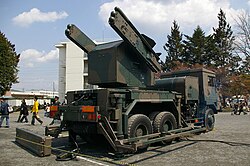Base supplies
Camouflage patterns
| Images | Model | Origin | Pattern type | Environment / colours | User | Period use | Notes |
|---|---|---|---|---|---|---|---|
 | Type I Camouflage | Woodland | Temperate (Based on Hokkaido's wilderness) | 1st Airborne Brigade (JGSDF Air Defense Artillery Groups) | 1970s to 1990s (limited use as of 2014) | First camo scheme adopted by Japan after World War II. [1] | |
 | Type II camouflage | Flecktarn | Temperate | JGSDF, JMSDF, Japan National Defense Academy cadets, JASDF Air Rescue Wings Pararescuemen | Since 1991 | Second domestically designed pattern. The earlier model had anti-IR/flame-resistant fabric, but the latter lacks the feature. [1] | |
 | Type II brown-dominant winter pattern | Flecktarn | Temperate / dark | JGSDF | Since 1991 | Darker contrast on Type II Flecktarn camo to fit the color of winter plants. Used on JGSDF Type-2 Camouflage Cold Weather Field Parka and Trousers. [1] | |
 | Type III camouflage | Flecktarn | Temperate | JGSDF | Since 2007 | Modified from ''Type II'' pattern. [1] | |
 | JGSDF Desert camouflage | Flecktarn | Arid / desert | JGSDF International Peace Cooperation Activities Training Unit and JGSDF Central Readiness Force | Since June 2010 | Adopted by the JGSDF for Middle Eastern deployments. [1] |
Protection
| Image | Model | Japan designation | Origin | Type | Notes |
|---|---|---|---|---|---|
| Combat helmet | |||||
 | PASGT helmet Personnel Armor System for Ground Troop | Type 88 helmet | Combat helmet (Kevlar) | Standard issue helmet. Successor of the Type 66 helmet. [2] Derived from the PASGT helmet. | |
 | M1 Helmet | Type 66 helmet | Combat helmet (iron alloy) | Entered service in 1966, it remains in use for non-combat missions, training exercises, parades and in the reserve forces. [3] [4] Largely replaced by the Type 88 helmet. | |
 | Ops-Core FAST Future Assault Shell Technology helmet | — | Combat helmet (UHMWPE material) | Used by special units. | |
| Body armour | |||||
 | PASGT Personnel Armor System for Ground Troop | Type 1 bulletproof vest | Bulletproof vest | First body armour fully introduced by the JGSDF in 1992. [5] Derived from the PASGT. | |
 | — | Type 2 bulletproof vest | Bulletproof vest | [6] [5] Successor of the Type 1 bulletproof vest . The camouflage is the Type II . | |
 | — | Type 3 bulletproof vest | Bulletproof vest | [7] [5] Successor to the Type 2 bulletproof vest . Procured with the fiscal year 2012 budget. | |
 | — | Type 18 Armoured Vest System | Bulletproof vest | [8] Successor to the Type 3 bulletproof vest . Procured with the fiscal year 2023 budget. | |
Electronic equipment
| Image | Model | Japan designation | Origin | Type | Quantity | Notes |
|---|---|---|---|---|---|---|
 | AN/PVS-14 | JGVS-V8 and | Personal night vision device GaAS visible light amplification 3rd generation | > 22,942 | License produced by NEC. |





















































































































